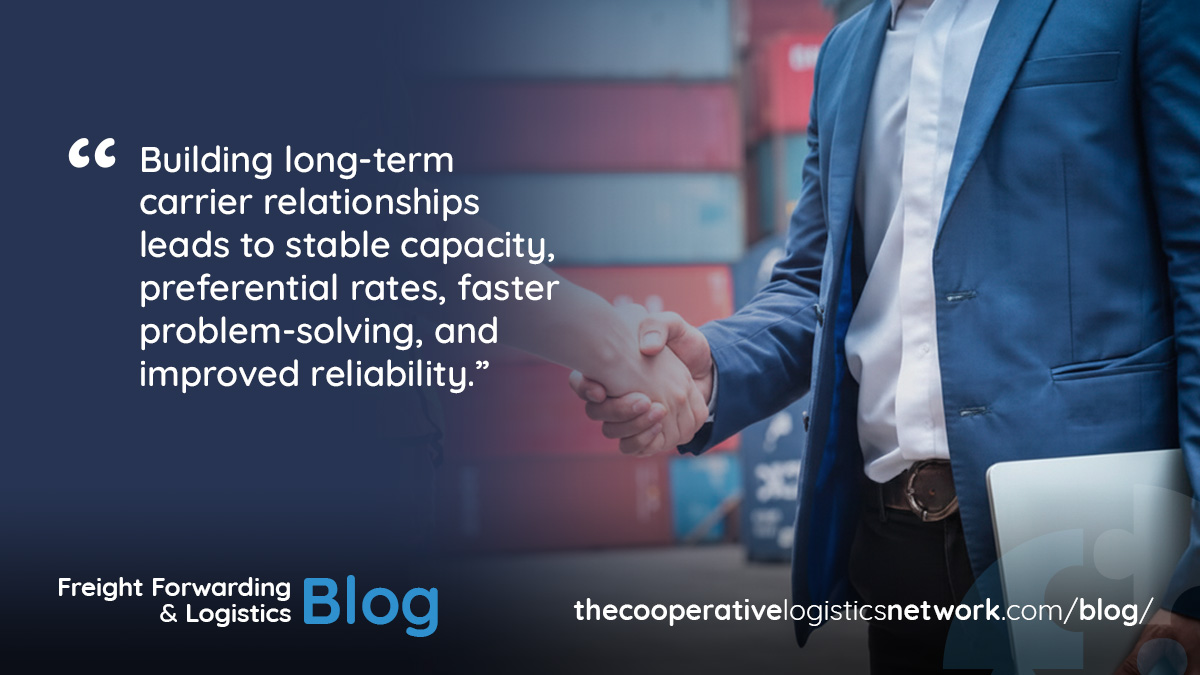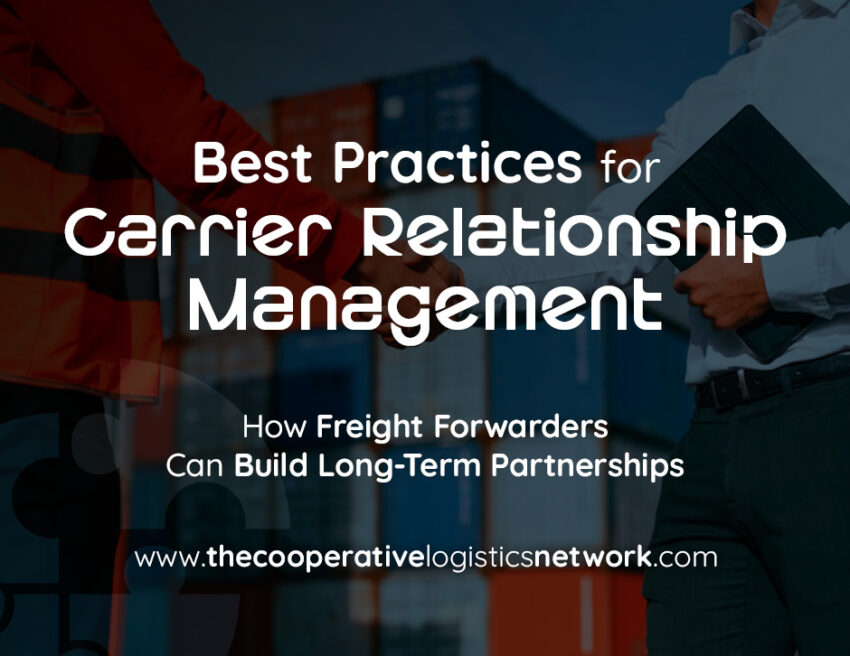In logistics, relationships are everything. While technology, automation, and analytics shape the modern supply chain, freight forwarders still rely on one crucial element for success which is strong, lasting partnerships with carriers. The ability to manage these partnerships effectively often determines whether a forwarder can offer reliable capacity, competitive pricing, and consistent service to their clients.
Let’s explore the best practices for carrier relationship management that help freight forwarders strengthen partnerships, improve performance, and gain a competitive edge in the long run.
Why Carrier Relationship Management Matters
Freight forwarding thrives on coordination. Every successful shipment depends on collaboration between multiple players such as carriers, customs brokers, warehouse operators, and clients. Among them, carriers are the backbone. They move the cargo, manage the risks, and ensure on-time delivery across global routes.
Yet, many freight forwarders treat carriers as transactional partners, rather than as collaborative partners to negotiate rates with. That’s a missed opportunity.
Building long-term carrier relationships leads to:
-
Stable capacity, even during peak demand or market disruptions.
-
Preferential rates, thanks to mutual trust and predictable business volume.
-
Faster problem-solving, when both sides work as partners rather than adversaries.
-
Improved reliability and service quality, benefiting the end customer.
In a volatile logistics market where capacity shortages, fluctuating rates, and global disruptions are the norm effective carrier relationship management is a strategic advantage, not an afterthought.

1. Communication: The Foundation of Every Strong Carrier Partnership
Open, consistent communication is the first step toward a productive relationship. Freight forwarders should keep carriers informed about upcoming projects, shipment forecasts, and potential challenges. Likewise, carriers should have the confidence to share constraints or issues before they escalate.
What this looks like in practice:
-
Scheduling regular performance reviews with key carriers to discuss on-time delivery rates, equipment availability, and feedback.
-
Sharing accurate forecasts of expected cargo volumes so carriers can plan resources better.
-
Being transparent about delays, last-minute changes, or documentation issues instead of waiting for problems to surface.
When both sides communicate proactively, it builds mutual trust and accountability which are the key ingredients for long-term collaboration.
2. Data-Driven Decision-Making and Performance Metrics
One of the best practices for carrier relationship management is using data to guide decisions instead of relying on assumptions or personal connections. Freight forwarders can use performance metrics such as:
-
On-time delivery rate
-
Load acceptance ratio
-
Claims ratio (damage/loss incidents)
-
Average transit time
-
Communication responsiveness
Tracking these indicators helps identify reliable carriers, highlight improvement areas, and create a transparent framework for evaluation.
Sharing this performance data with carriers also fosters collaboration. Instead of blaming, both sides can focus on measurable improvements. This transparency strengthens credibility and sets clear expectations.
Additionally, using digital tools such as Transport Management Systems (TMS), visibility platforms, and predictive analytics enables freight forwarders to evaluate carrier performance in real time. It allows for faster decision-making, improved accountability, and smoother coordination.
3. Balance Negotiation with Partnership
It’s easy to think that carrier management is all about getting the lowest possible rate. But successful forwarders know it’s about value, not just cost. Overly aggressive negotiations can strain relationships and result in poor service when capacity tightens.
Instead, focus on mutual benefit. Negotiate fairly and commit to predictable shipment volumes or longer-term contracts in exchange for better rates and reliability. When carriers see you as a dependable partner who values their service, they’re more likely to prioritize your cargo during busy seasons.
A win-win partnership approach helps both sides weather market fluctuations together. It turns short-term deals into sustainable business alliances.
4. Technology Integration and Visibility
Technology now plays a key role in carrier relationship management best practices. Freight forwarders who embrace digital solutions make collaboration faster, more transparent, and more efficient.
For example:
-
Digital booking platforms streamline load assignments and confirmations.
-
Real-time tracking tools enhance shipment visibility and reduce communication delays.
-
Integrated invoicing and payment systems minimize disputes and speed up settlements.
When carriers and forwarders operate within a shared digital ecosystem, errors decrease, communication improves, and operational trust deepens.
Many forwarders are also using predictive analytics to forecast carrier performance based on historical data, ensuring smarter partner selection and proactive issue resolution.
5. Build Relationships Beyond the Transaction
Carriers are more than service providers; they’re business partners. The best freight forwarders invest time in building personal connections beyond the daily operational exchanges.
That could mean meeting your carrier partners at trade events, visiting their facilities, or inviting them to joint planning sessions. Even small gestures like a phone call to acknowledge good performance or a thank-you note after resolving a tough situation can reinforce loyalty. A genuine partnership mindset ensures that both sides remain invested in each other’s success. When a carrier knows you value their contribution, they’re more likely to go the extra mile when it matters most.
6. Collaboration on Sustainability and Innovation
Sustainability is no longer optional in logistics. Clients increasingly expect freight forwarders and carriers to align with green supply chain practices. Collaborative efforts between forwarders and carriers on emission reduction, route optimization, and alternative fuels can strengthen partnerships and appeal to environmentally conscious clients. Similarly, innovation partnerships like piloting new visibility tools or testing IoT-based temperature sensors can benefit both parties. When forwarders involve carriers in innovation efforts, they build relationships based on progress, not just price.
7. Crisis Management and Flexibility
A forwarder’s true test of relationship management comes during crises, whether it’s port congestion, strikes, weather disruptions, or equipment shortages. The way you handle these moments determines the future of your carrier partnerships. Forwarders should maintain contingency plans, share updates quickly, and remain flexible when carriers face unavoidable setbacks. Offering understanding during tough times fosters loyalty that money can’t buy. In return, reliable carriers will prioritize your loads when markets tighten or capacity becomes scarce.
8. Continuous Improvement and Feedback Loops
The best partnerships evolve through feedback. After major projects or peak seasons, forwarders should hold review sessions with carriers to discuss what worked well and what could improve. Encourage carriers to share their perspective too, maybe documentation delays or unclear instructions created inefficiencies. Constructive feedback both ways shows respect and a shared goal of better performance.
Regular feedback loops are one of the most underrated yet powerful best practices for carrier relationship management, turning operational hiccups into learning opportunities and long-term gains.
The Long-Term View: Partnership Over Procurement
In freight forwarding, long-term success comes from reliable relationships, not one-off rate wins. Carriers who trust you will give priority during crunch times, offer flexible terms, and even share strategic insights about upcoming market trends.
The ultimate goal of carrier relationship management is to create a partnership where both sides grow together thus delivering consistent value to shippers, clients, and end customers. When freight forwarders focus on collaboration, communication, and continuous improvement, they move beyond being middlemen. They become strategic partners who drive efficiency, reliability, and innovation across the supply chain.
Final Thoughts
The logistics industry is built on partnerships and few are as critical as the bond between forwarders and carriers. Implementing the best practices for carrier relationship management allows freight forwarders to secure capacity, improve service quality, and stand out in a crowded market. Technology, transparency, and trust are the foundation. But the real differentiator lies in treating carriers not as vendors, but as collaborators in your success. In a business where reliability defines reputation, strong carrier relationships aren’t just good practice — they’re your biggest asset.


